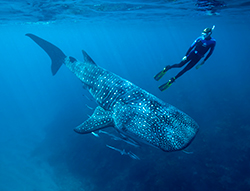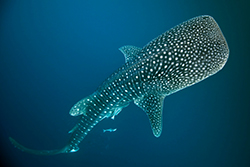How do the world’s largest fish – whale sharks – reach such immense sizes when they feed on some of the smallest prey in the ocean?
The answer, according to a new study, is that whale sharks are very efficient foragers, using a combination of "yo-yo" like swimming to save energy and specially-adapted bodies to maximise heat conservation as they search for "krill" (tiny, shrimp-like animals) that they feed on in cold ocean depths.
Dr Mark Meekan, Principal Research Scientist at the Australian Institute of Marine Science (AIMS), is lead author of the study and explains their findings,
“Whale sharks are negatively buoyant meaning they naturally sink. When feeding, they allow themselves to glide gently down to the krill in deep water, which means they don’t expend much energy in swimming".
“We estimate that this behaviour, followed by a steep return to the warmer surface waters, allows them to conserve up to 30% of the energy they would use if just swimming horizontally".
“These ocean giants have another trick up their sleeve”, says Dr Meekan. “Their critical organs are surrounded by huge blocks of white muscle that appear to insulate the whale shark, so that it stays warmer for longer, even during these long descents to much cooler depths”.
“For whale sharks, the larger they get, the more heat they can store and the longer they can forage in deep water”, notes Dr Meekan. “Because of this, we think they have evolved to become bigger and bigger, so that today they grow up to 18 metres long and can reach 34 tonnes in weight – larger even than many whales”.
The scientists were able to record the swimming behaviour and location of whale sharks near Ningaloo Reef in Western Australia using sophisticated data and video recorders and satellite tags. They found that whale sharks spent almost 60% of their time at the surface, where they bask in warm waters.
“Whale sharks will dive down as deep as 500 metres and the water temperature can drop up to 20 degrees”, explains Dr Meekan, “they therefore need to spend a lot of their time at the surface to heat up again before pursuing their tiny prey in the cold ocean depths".
“Unfortunately for these magnificent creatures being at the surface for such long periods can leave them vulnerable to encounters with large container vessels, tankers or even hunters".
“Up to 25% of the whale sharks in the Indian Ocean bear scars from boat-strikes, and our research helps us understand why this is happening. We now need to educate others to this danger and try to manage our behaviour to better protect these giants of the ocean”.
The paper “Swimming strategy and body plan of the world’s largest fish: implications for foraging efficiency and thermoregulation” by Mark Meekan, Lee Fuiman, Randall Davis, Yuval Berger and Michele Thums appears in the journal Frontiers in Marine Science
http://journal.frontiersin.org/article/10.3389/fmars.2015.00064/abstract
For further information, please contact:
Dr Mark Meekan, AIMS, +61 (08) 6369 4039 or +61 (0) 429 101 829 (Australian Western Standard Time, GMT+8)
Steve Clarke, AIMS, +61 (0)7 4753 4264 or S.Clarke@aims.gov.au



